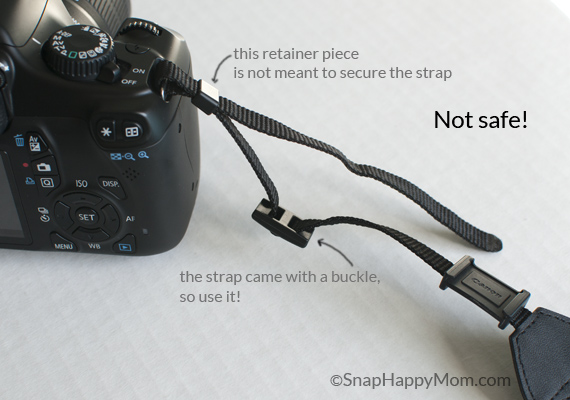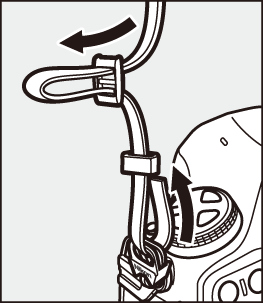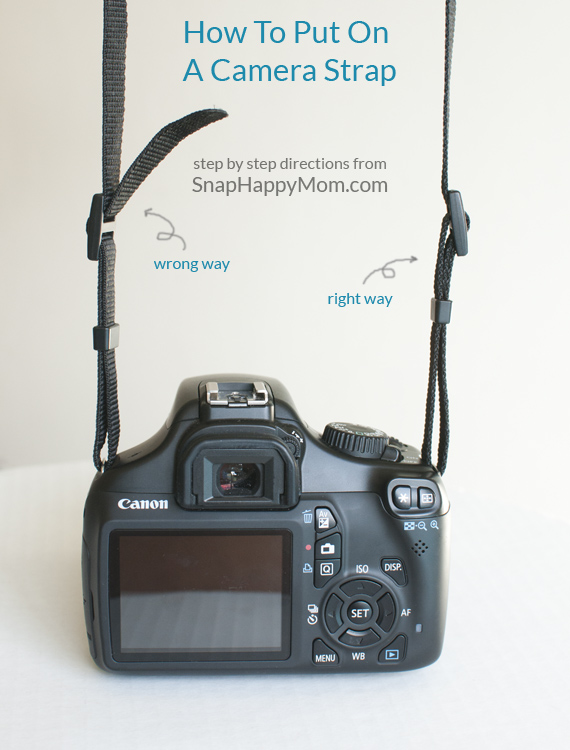To put a camera strap on, thread the end through the camera’s strap loops and secure it. Ensure it is tightly attached for optimal comfort and safety.
Having a camera strap is essential for photographers and enthusiasts to secure their precious gear. It helps prevent accidental drops and ensures better stability while capturing those memorable moments. Learning how to properly attach a camera strap is a basic yet crucial skill for every photographer.
We will guide you through the simple steps of putting on a camera strap to keep your equipment safe and your hands free for effortless shooting. So, let’s dive in and get your camera strap securely fastened for your next photo adventure.
Choosing The Right Camera Strap
Choosing the right camera strap is an essential decision for any photographer. A camera strap not only holds your valuable equipment securely but also provides comfort during prolonged use. When it comes to selecting the perfect camera strap, there are a few key factors to consider. In this article, we will dive deeper into these considerations, allowing you to make an informed choice for your photography needs.
Consider The Length
One of the first aspects to think about when choosing a camera strap is its length. The length of the strap can impact how you carry your camera and how it feels while shooting. Most camera straps come in standard lengths, but it’s crucial to find one that suits your shooting style and body type. A strap that is too short may restrict your movements, while a strap that is too long can get in the way or become tangled. Take your time to determine the ideal length that allows you to work comfortably and efficiently.
Material Matters
Another important consideration is the material of the camera strap. Camera straps are available in a variety of materials, including nylon, leather, and neoprene. Each material has its advantages and disadvantages. Nylon straps are lightweight and durable, making them an excellent choice for active photographers who frequently shoot outdoors. Leather straps, on the other hand, offer a classic and stylish look while providing exceptional durability. Neoprene straps provide comfort and are perfect for photographers who prefer longer shooting sessions. Consider your shooting conditions and personal preferences to choose the material that best suits your needs.
Comfort And Padding
Comfort is paramount when it comes to selecting a camera strap. A comfortable strap allows you to shoot for extended periods without experiencing fatigue or strain. Look for straps with adequate padding to ensure maximum comfort. Thick padding evenly distributes the weight of your camera, preventing any discomfort on your shoulders or neck. Additionally, some straps feature breathable materials that help reduce sweat buildup during warm weather or intense shooting sessions. Prioritize your comfort and choose a strap that allows you to focus on capturing incredible images rather than experiencing discomfort.
By considering these key factors, such as length, material, and comfort, you can select the perfect camera strap that enhances your photography experience. A well-chosen camera strap not only provides security for your equipment but also ensures you can focus on capturing those amazing moments without any distractions.
Preparing Your Camera
When it comes to preparing your camera, it’s essential to ensure that the attachment points are clean and ready to secure the new camera strap. This will help to maintain the integrity of your camera and provide a secure connection for the new strap.
Remove Existing Strap
To begin, carefully remove the existing camera strap by detaching it from the attachment points on the camera body. Depending on the type of strap, this may involve unclipping or unscrewing the attachment hardware. Be sure to set the old strap aside in a safe place for storage or disposal.
Clean The Attachment Points
Next, inspect the attachment points on the camera body to ensure they are free from dust, debris, and any residual adhesive from the previous strap. Use a clean, dry cloth or a mild cleaning solution if necessary to gently wipe down the attachment points, ensuring they are clean and dry before attaching the new camera strap.
Attaching The Camera Strap
Identify Attachment Points
- Locate the metal rings or eyelets on each side of the camera body.
- Ensure they are sturdy and designed to hold the weight of the camera.
Thread The Strap
- Pass one end of the strap through the first attachment point.
- Make sure the strap is securely threaded through the attachment point.
Adjust Length And Position
Attach the other end of the strap to the second attachment point.
Pull the strap to adjust the length according to your comfort level.
Position the strap over your shoulder or neck for easy access to the camera.

Credit: m.youtube.com
Securing The Strap
When securing the camera strap, it’s important to follow proper steps to ensure the safety of your equipment. The way you secure the strap can affect how securely your camera is attached to your body.
Double Check The Connections
Always double check that the strap is properly attached to your camera body. Make sure the connection points are secure to prevent any accidental detachment.
Ensure A Snug Fit
To ensure a snug fit, adjust the length of the strap so it sits comfortably across your body. A properly fitted camera strap will help prevent strain and discomfort during use.
Using The Camera Strap
When using a camera, it is essential to know how to properly wield its accompanying strap. The camera strap serves as a crucial tool for keeping your camera secure and easily accessible, freeing your hands for other tasks.
Wearing The Strap Correctly
To wear the camera strap correctly, place it over your shoulder, ensuring it rests comfortably. Then, adjust the length to allow the camera to hang around your chest or hip level, depending on your preference, for ease of access.
Be Mindful Of The Weight
Be mindful of the camera’s weight and how it affects your body. If you are using a heavier camera, distribute the weight evenly across your body by wearing the strap diagonally across your chest, or consider utilizing a padded strap for added comfort.
Learn Proper Handling Techniques
Learning proper handling techniques is crucial for ensuring your comfort and safety when using a camera strap. Always hold the camera securely with one hand while using the other to adjust settings or take photos. Avoid leaving the camera dangling freely, as this can lead to accidental damage or injury.

Credit: snaphappymom.com
Maintaining Your Camera Strap
Your camera strap plays a crucial role in keeping your camera secure and accessible while you capture those amazing moments. To ensure that your camera strap remains in optimal condition, it’s important to follow a few maintenance steps. By regularly cleaning and inspecting your camera strap, you can identify any signs of wear and tear early on and take the necessary steps to keep it in top shape. Here’s a guide on how to maintain your camera strap:
Cleaning And Care
Keeping your camera strap clean will not only improve its appearance but also extend its lifespan. Here are some quick tips on how to clean and care for your camera strap:
- Regularly wipe down your camera strap with a damp cloth to remove dirt, dust, and grime.
- For stubborn stains, spot clean the affected area using a mild soap solution and a soft brush or sponge.
- Avoid immersing your camera strap in water or using harsh chemicals as this can damage the material.
- After cleaning, ensure that your camera strap is completely dry before reattaching it to your camera.
Inspecting For Wear And Tear
Regularly inspecting your camera strap is essential to identify any signs of wear and tear. Here’s how to inspect your camera strap:
- Check the attachment points of the strap to the camera body for any looseness or damage.
- Inspect the strap for any fraying, tears, or worn-out stitching.
- Examine the hardware, such as hooks or clips, for any signs of rust or damage.
- Test the adjustability of the strap to ensure it can be securely adjusted to your preferred length.
Replacing As Needed
If during the inspection, you notice significant wear and tear that compromises the functionality and safety of your camera strap, it’s time to consider replacing it. Here are a few signs that indicate the need for a new camera strap:
- Visible tears, fraying, or worn-out stitching that cannot be repaired.
- Loose or damaged attachment points that no longer provide a secure connection to your camera.
- Rust or corrosion on the hardware that affects its durability and reliability.
- Unreliable adjustability that makes it difficult to find the right strap length for your comfort.
By following these maintenance tips, you can ensure that your camera strap remains in excellent condition, providing you with both comfort and peace of mind during your photography adventures.
Alternative Carrying Options
Discover alternative carrying options for your camera strap to ensure comfort and practicality. Loop the strap over your shoulder and adjust for a secure fit, providing ease of access while on the move. Explore various ways to put on your camera strap for a hassle-free photography experience.
Consider A Sling Strap
If you’re tired of the traditional camera strap that goes around your neck, a sling strap might be the perfect alternative carrying option for you. Sling straps are designed to distribute the weight of your camera across your shoulder, providing a more comfortable and secure way to carry your gear. By allowing your camera to hang by your side, a sling strap keeps your hands free and your equipment easily accessible.
There are several benefits to using a sling strap. Firstly, it helps prevent strain on your neck and shoulders, especially during long hours of shooting. With a sling strap, you can comfortably carry your camera for extended periods without experiencing any discomfort.
Additionally, a sling strap offers greater freedom of movement. Whether you’re hiking, attending an event, or simply exploring the city streets, a sling strap allows you to move with ease while keeping your camera readily available. No more fumbling with a neck strap or worrying about accidentally dropping your camera.
Furthermore, sling straps typically feature quick-release buckles, making it easy to detach your camera when you need to use a tripod or stabilize your shots. This level of convenience and versatility is essential for photographers who require quick access to their equipment.
Exploring Wrist Straps
If you prefer a minimalist approach to carrying your camera, a wrist strap might be the ideal choice for you. Wrist straps provide a secure way to keep your camera close by without adding extra bulk or weight.
One of the key advantages of a wrist strap is its simplicity. With your camera securely attached to your wrist, you can shoot with confidence, knowing that it won’t accidentally slip from your grip. Wrist straps are particularly suitable for photographers who frequently need to use their hands while still having their camera readily available.
Moreover, wrist straps are often adjustable, allowing you to find the perfect fit for your wrist size. This ensures maximum comfort and eliminates any concerns about the strap being too loose or too tight.
Another benefit of wrist straps is their portability. They take up minimal space in your camera bag, making them an excellent option for travelers or those who prefer to carry their gear with minimal fuss. Plus, wrist straps are quick and easy to attach and detach, making it convenient to switch to a different carrying option when needed.
Harness Or Holster Systems
If you’re a professional photographer or someone who frequently carries multiple cameras or heavy equipment, harness or holster systems are worth considering. These advanced carrying options provide excellent support, allowing you to comfortably handle the weight of your gear.
Harness systems are designed to distribute the weight across your shoulders and back, similar to a backpack. This helps alleviate strain on your neck and allows you to carry multiple cameras or additional accessories without discomfort.
On the other hand, holster systems are ideal for photographers who prefer to have their camera securely attached to their waist or hip. The holster keeps your camera within reach while ensuring it stays in place, even during active shooting. Holster systems offer ease of access, quick draw capabilities, and the ability to quickly secure your camera when necessary.
Both harness and holster systems provide superior stability and control, allowing you to move freely and capture your shots with confidence. When choosing between the two, consider your shooting style, the amount of equipment you carry, and the level of comfort you desire.

Credit: onlinemanual.nikonimglib.com
Conclusion
Properly attaching a camera strap is essential for photographers. Ensuring the strap is securely fastened can prevent accidents and provide peace of mind while shooting. By following the steps outlined in this guide, you can confidently and safely utilize your camera strap, enhancing both comfort and security during your photography sessions.


0 comments